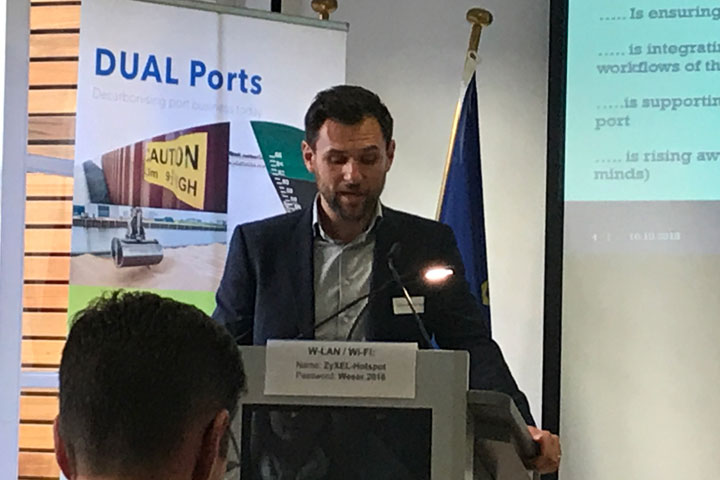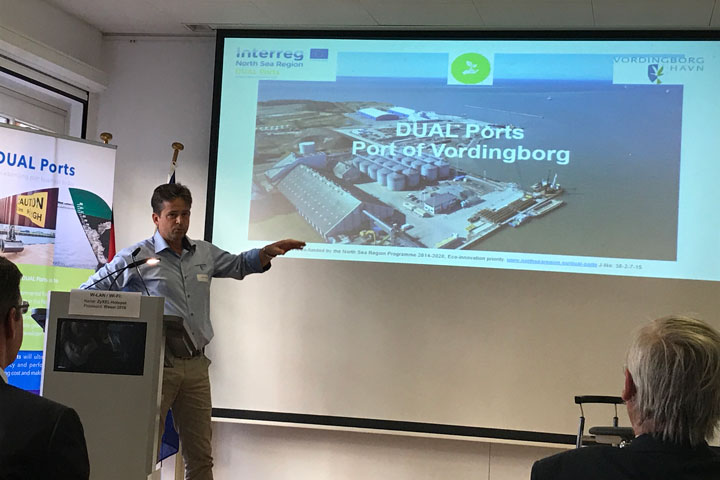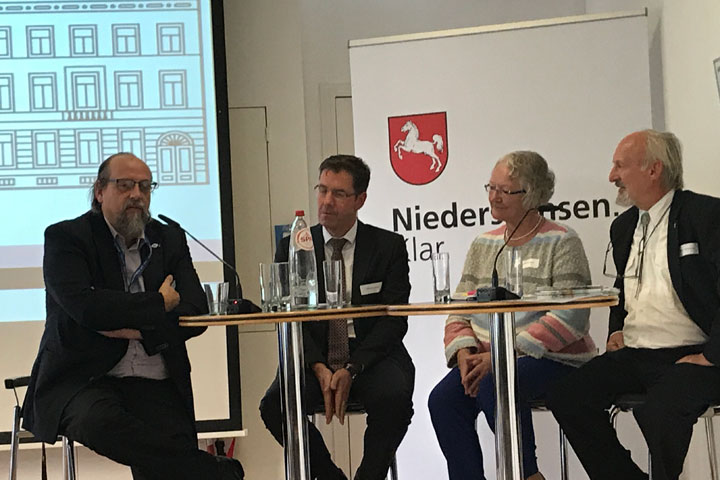In a world where sustainability is increasingly in focus and ships are growing in size and volume, is there a future for smaller, regional ports? A workshop hosted by the North Sea Region funded project DUAL Ports provided some interesting answers.
 On 10 October, the DUAL Ports project held a workshop in Brussels entitled Innovative green port solutions in small and medium sized ports.
On 10 October, the DUAL Ports project held a workshop in Brussels entitled Innovative green port solutions in small and medium sized ports.
The DUAL Ports project aims to decarbonise regional entrepreneurial ports through a shared eco-innovation programme and runs eight pilots demonstrating green port concepts.
The workshop was organised as a side event at the EU Week of Regions and Cities and brought together key stakeholders in a lively discussion on the greening of smaller ports.
Blue growth – a key driver of European economy
Gesine Meissner, President of the European Parliament’s Intergroup on Seas, Rivers, Islands and special envoy on Maritime Policy, highlighted the role of regulatory frameworks in driving the greening of European ports.
She recognised the role of EU-funded projects like DUAL ports in helping regional ports meet upcoming sustainability demands. According to Meissner, DUAL Ports is ‘a very good project which can really bring us a step forward by stimulating eco-innovation in ports.’

Felix Leinemann of DG Mare agreed, commending the DUAL Ports project for trailblazing solutions that complement other initiatives across Europe. He underlined the growing economic importance of European blue growth, currently with an estimated turnover of 566 billion €, creating minimum 3.5 million jobs and with many emerging businesses driven by new technology e.g. within circular economy, desalinisation, big data, sensors, and autonomous vessels.
Pilots show positive results
Two DUAL Port pilots were presented at the workshop:
GREEN OFFICER: Sustainability manager at the German Niedersachsen Ports Matthäus Wuckowski presented the pilot’s sustainability strategy that incorporates eco-innovation as well as other aspects such as growth and customer satisfaction. The strategy is now driving numerous types of innovation, such as the installation of an intelligent LED lighting system where lights are automatically switched on when needed.

SOIL: Development Manager Jan-Jaap Cramer presented how the Danish Port of Vordingborg is using construction and demolition waste, fly ash, and slag to expand the port. This reduces the cost of the expansion, saves costs of depositing the waste, and speeds up the port construction since the materials are readily available in the local area. Also, recycling local waste material reduces the carbon footprint due to avoided transport.

Initial cost-benefit analyses by the Hamburg Institute of International Economics indicate that the money invested into both pilots has been well-spent.
EU frameworks key to greening of regional ports
Much of the discussion revolved around the challenges facing ports and how EU policy and incentive frameworks may help.
Wim Stubbe of the Flemish Port of Oostende, Flanders (the Lead Beneficiary of DUAL Ports) was clear on why EU funding is crucial: ‘Small and medium ports need EU support due to lack of resources and expertise’, he said, explaining that many small ports are run by less than a handful of people.
Sotiris Raptis of the European Sea Ports Organisation (ESPO) called for tax exemptions for shoreside power supply. This would put electricity on a more equal footing with bunker oil and other fossil fuels that are currently exempt from energy tax when used for shipping.

However, it can be difficult for smaller ports to attract electricity companies. The company Blue Power Synergy presented a new invention which might solve the issue: A floating, solar-powered device designed to provide power for ships. ‘The EU should provide the platform for realising this kind of invention’, Wim Stubbe suggested.
The strong global trend of supersize sea carriers was also brought up as a core challenge for the smaller ports. ‘What we really need is ships that are smaller, smarter, and lighter. The building of smaller ships should be better incentivised,’ said Jan-Jaap Cramer.
Transnational cooperation bolsters regional ports for the future
Do the trends of supersized vessels and increasing sustainability requirements put the future of regional ports at stake? Not necessarily. Smaller ports are still needed for effective hinterland transport and also have a role to play in the local community, e.g. by catering to off-shore energy facilities. And as DUAL Ports shows, transnational cooperation helps the smaller ports make headway and innovate for sustainability, in a way that is tailored to their needs.

Delegates found that transnational cooperation speeds up positive development in smaller ports due to the knowledge transfer between partners. Also, the DUAL Port pilots form a basis for further initiatives reaching into the future. For example, Niedersachsen Ports’ sustainability strategy has paved the way for a systematic approach to eco-innovative port development and has led the ports to set green targets for 2025, e.g. for the launch of hydrogen utilities.
The pilots also inspire other ports. According to Wim Stubbe, the eco-innovation efforts of the Port of Oostende are already garnering significant attention: ‘We have at least two visits every month from foreign delegations. Even people from India and Taiwan come to learn about our activities.’

The workshop thus revealed that there is both a challenge and an opportunity for smaller ports to diversify, to specialise and even to become a laboratory for innovation in logistics, port management and blue growth.
Learn more about the DUAL Ports project
Top image by Wim Stubbe / Port of Oostende.
